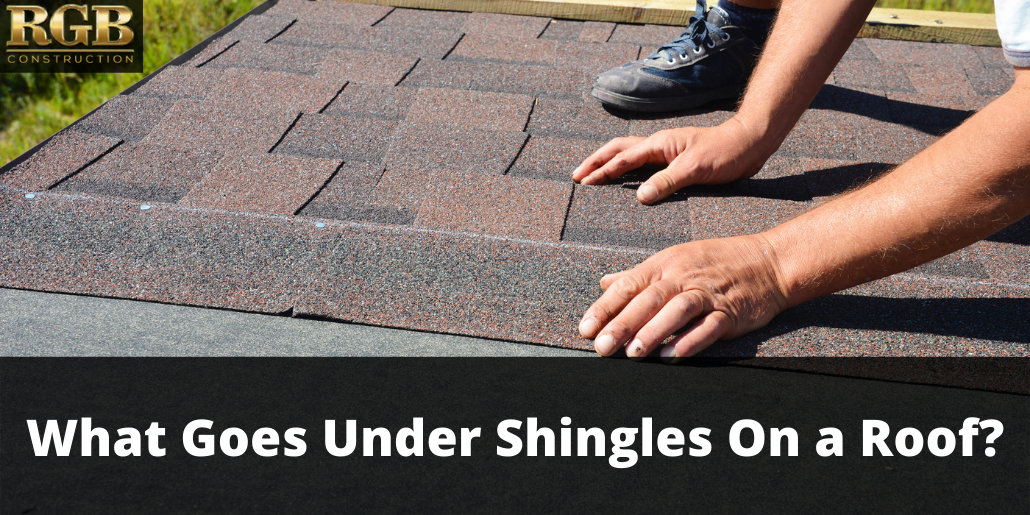When you take a look at the roof on your home, you will notice the shingles first and foremost. After that, there is not much more to see. That is because the shingles are doing their job of keeping everything underneath them out of sight. Unless you start ripping off the shingles yourself to replace or repair, you may never know just how many layers are hidden beneath the most visible roofing materials.
The fact is that there are multiple layers beneath the shingles that are meant to block out moisture. Since understanding what goes under the shingles on a roof can help you out in the future, we’ve come up with a quick guide to explain everything you need to know.
Let’s begin.
Layers Under Shingles on a Roof
Starting from the bottom of a roof up, here is everything that goes under the shingles:
Frame
This is the part of the house that is meant to support the weight of all the roofing materials that will eventually be installed on top. This includes the roof trusses. Some roofing materials, like clay or slate, are heavier and thus require a reinforced frame.
Insulation
To prevent the loss of warmth rising up through your home, insulation is added to the attic space. If your attic is finished, the insulation will be found in between the rafters.
Roof Deck
Next comes the roof deck, which is the sheets of plywood that sit on top of the roof trusses
Water Shield
The layer after the roof deck is a waterproof barrier or membrane that is designed to prevent the buildup of moisture and ice around the eaves of the roof. The water shield is usually a peel-and-stick membrane that attaches directly to the roof deck.
Underlayment
Directly beneath the shingles is something called “underlayment,” also known as “roofing felt.”
As you may have guessed, underlayment is usually either made of fiberglass paper or felt. It covers the entire roof deck. Though it is breathable enough to assist with ventilation, underlayment will stop liquids from seeping through to the more vulnerable parts of the roof.
After the underlayment is in place, the visible sections of the roof start coming together. That includes the shingle starter strips, the roofing material itself, ridge vents, and flashing.
All About Underlayment
Since underlayment is such an integral piece of your roof, let’s go into more detail. As mentioned earlier, underlayment is either water-resistant or waterproof that is placed beneath the main roofing materials.
There are three kinds of roofing underlayment:
- Asphalt-saturated felt
- Non-bitumen synthetic underlayment
- Rubberized asphalt underlayment
The first two are the most common.
Asphalt-Saturated Felt
Up to about 15 years ago, felt underlayment was one of the most popular forms. This kind of underlayment is commonly called tar or felt paper and can either be made with natural materials, such as wood cellulose, or synthetic materials, like polyester or fiberglass. The base materials are then soaked in a protective coating made of bitumen (asphalt) or something similar. The bitumen allows the underlayment to breathe but will repel water.
Synthetic Underlayment
Presently, non-bitumen synthetic underlayment is the preferred option among contractors. It is similar to felt paper in construction but has enhanced durability. The synthetic materials are saturated in asphalt. Fiberglass is added in, increased resistance to tearing and punctures. Some brands, like CertainTeed, even added a scrim reinforcement for slip resistance, even if the underlayment gets wet.
Rubberized Asphalt
Compared to the other two types of underlayment, rubberized asphalt is the most expensive because of a higher amount of rubber and asphalt polymers. This underlayment has a sticky back that allows it to adhere directly to the roof deck, creating a waterproof seal. If you are located in a region that has harsh winter conditions, rubberized asphalt is extremely helpful. The underlayment will even protect the edges of the roof deck from water damage.
Why These Layers Are Useful
You may be wondering why all these pieces of the roof are necessary. The most basic answer is protection. Without layers and underlayment, your home would feel colder, more damp, and, in the event the shingles got damaged, would be dripping with water almost immediately.
Underlayment is especially vital for several reasons:
Moisture Barrier
Shingles alone cannot provide all the protection. See, shingles are for stopping impacts and reflecting sun. They also sheet off water, but shingles are not sealed at the corners, and they can be torn off in high winds. Plus, shingles can get brittle over time. So, underlayment is necessary for supplying an extra shield from water and ice and heat loss, as well as ice damming.
Class A Fire Rating
When roofing materials are tested for their fire ratings, it is done on a small roof deck with felt underlayment. Without the underlayment, the shingles may not be able to meet Class A fire requirements, which means that your home wouldn’t meet building codes without it.
Improves Overall Look and Uniformity
The roof deck does not always lay perfectly. If you were to install shingles directly to the roof deck, that uneven surface would cause a lot of vulnerable spaces for water to go, and it would look bad, too. A layer of felt paper or another kind of underlayment helps create a uniform surface for shingles to be installed.
Bottom Line
Now if someone was to ask you what is under shingles on a roof, you should be able to answer them. Roofing is more than one layer—it’s several—and while that top layer of hard shingles is essential, the underlayment is required too. Without those layers, your roof would not be as durable or as water-resistant as you know it to be.
Have questions about roofing underlayment? Need some work done on your roof? Give us a call or contact us by filling out the contact form. Our professional team is ready to help.







